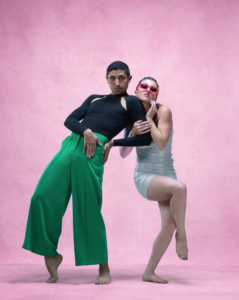Litvak’s “Dancing Outdoors” Offers Strong Geographic, Emotional Range

Nick McGhee (his duds were campier in the show) and Ashley Akhavan
Strutting out in glitter and fur, Ashley Akhavan and Nick McGhee own the stage in “I hear everybody you know is more relevant than everybody I know.” Dipping, pivoting, vamping, Akhavan is all cool hauteur, while McGhee flashes a “please like me” smile. This deliciously cheeky piece opened “Dancing Outdoors Take 2,” Litvak Dance’s show in the courtyard of ICA in Encinitas on Saturday.
The strong program, curated by Litvak director Sadie Weinberg, featured five companies ranging geographically from Los Angeles to Tijuana. “I hear everybody you know … ” was set on Litvak dancers by L.A.’s Whyteberg—Gracie Whyte and Laura Berg—who “make colorful immersive works for non-traditional spaces.” (See some fun snippets here.)
Also from L.A., Entity Contemporary Dance combines modern, jazz, and hip hop. Its dancers hail from the commercial dance world. Entity artists Shiori Kamijo and Jason Martin brought gorgeous form and nonstop tension to “Anagnorisis,” named for the point in a play or novel when a character recognizes a painful truth. The piece felt like one of the really memorable numbers on “So You Think Can Dance,” with a strong sense of story conveyed by the two standing close, one behind the other, yet avoiding eye contact; finally coming face to face, they go into intense unison turns and arm flings. On the SYTYCD downside, there are jerks and twitches that felt thrown in as if only to add more moves per second.
The brilliant Tijuana troupe Lux Boreal did “Architecture of Shadows,” a propulsive, acrobatic piece in which three dancers (Angel Arámbula, Ilse Meza, Melissa Padilla) appear driven by some ominous force. They dancers often drop to the ground, scrambling, crawling, rolling, or pushing against it. At times they struggle, for instance when Arámbula constrains one of the women’s arms; elsewhere, they try to communicate with gestures. And are they antagonists … or are they all in this together? The ambiguity is one of the pleasures this complex dance.
Litvak, based in Encinitas, offered two excerpts from longer works, Weinberg’s “Light” and “Estirpe,” by company member María José Castillo.
Weinberg introduced “from darkness comes light,” as the story of a Jewish woman whose true love is killed by the Spanish Inquisition. The dance opens with the woman (Erica Ruse, always beautifully emotive) harassed by an Inquisitor (Jordan Daley) wearing a costume I couldn’t take my eyes from—a tall pointed black hat and black-and-white paneled puffed skirt that looked like a creation by Bauhaus artist Oskar Schlemmer. (Betzi Roe and Weinberg did the design.)
Ruse tries to move forward, but the Inquisitor blocks her, even slinging her roughly over his shoulder. A resolute woman in white (Emily Miller) appears and takes her side, and the two triumph. The program lists Miller’s character as Shekinah, and if you happen to have studied Kabbalah, you’d know the Shekinah is the indwelling feminine presence of God. This may all come together beautifully in the completed work. But in this bit that’s heavy on narrative—not to mention requiring knowledge of Kabbalah— the clear visual element of the Inquisitor’s stunning costume stole the show.
In “Estirpe” (Spanish for lineage), Castillo weaves together her two heritages: her deep roots in Mexican folklorico, in which she trained and performed extensively, and her study and performance of contemporary dance. The excerpt she showed here was lushly romantic with three couples doing sweeping, folklorico-flavored partnering—and exchanging melting glances—to live music. Castillo created this work to be performed with mariachi musicians, but they weren’t available. No problem, it felt seamless with the songs—Sabor a mí and Quizás, Quizás, Quizás—done by the Brazilian, Afro-Cuban band La Perla, who also performed during the intermission.
The Rosin Box Project is a San Diego contemporary ballet company founded by Carly Topazio, a veteran of the Alabama Ballet and City Ballet of San Diego. She and Jeremy Zapanta created and danced “Disorientation,” a fraught pas de deux in which they seem lovers doomed to be separated, whether by fate or by issues between them. She writhes and looks stricken, as he launches himself into slides on the Marley dance floor … although why? This move and others didn’t feel motivated, and ultimately the piece didn’t engage me emotionally. Still, there’s plenty of lovely dance here, including partnering showing off Topazio’s strong lines.
